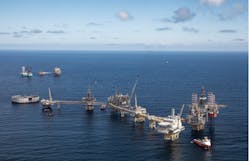North Sea Ekofisk field reaches 50-year milestone
Offshore staff
TANANGER, Norway – ConocoPhillips Norge has commemorated 50 years of production from the Ekofisk field in the southern Norwegian North Sea.
At the same time, the company has started production from the re-developed Tor field satellite, 13 km (8 mi) northeast of the Ekofisk Complex. Tor began producing in 1978 and was shut in 2015: the new development is based on eight wells divided between two subsea templates.
Originally, ConocoPhillips expected Ekofisk to cease operations in 1997. However, the introduction of water injection in the late 1980s improved recovery, helping to prolong production.
Ekofisk produces from a reservoir 3,000 m (9,842 ft) subsurface. To date more than 3 Bbbl have been produced from the 300-m (984-ft) oil column.
Currently, the company is assessing new development projects in the Greater Ekofisk Area (GEA), along with recent discoveries elsewhere in the North Sea and in the Norwegian Sea.
Since 1971, the GEA has created estimated value of close to NOK 2,600 billion ($314 billion), with 4.2 Bbbl produced from the Ekofisk field, 1.1 Bbbl from Eldfisk, and 0.8 Bboe from other fields in the area. The recovery rate of more than 50% has comfortably exceeded the original target of 17%.
Around 3,000 people work in the GEA, with 1,000 offshore on the platforms, rigs and vessels, supported by around 900 employees at the Tananger headquarters in southern Norway.
Over the past two decades the company has implemented various emissions reductions measures in the GEA. For instance, it commissioned a new power cable between the Eldfisk Complex and the Eldfisk 2/7 B platform to replace diesel-driven power with steam power.
The project should cut CO2 emissions by 1 MM metric tons/yr and NOx emissions by 167 metric tons/yr (184 tons).
Hybrid power solutions installed in three platform supply vessels are reducing diesel consumption by up to 15%, along with emitted NOx and CO2.
Late last year a new project got under way to restrict flaring at the Ekofisk J platform. From 2022 this should cut CO2 emissions at Ekofisk by 26MM metric tons/yr (28,660 tons).
Finally, Norway’s authorities have imposed a maximum oil-in-water content in produced water from the country’s offshore fields to 30 mg/l. The oil in water concentration in the GEA fell to 6.9 mg/l in recent years.
06/10/2021
